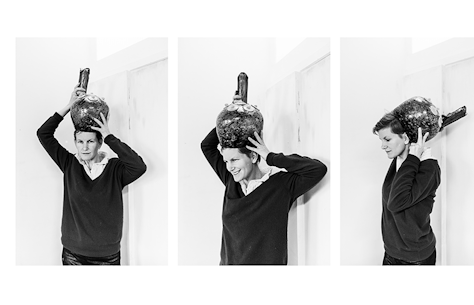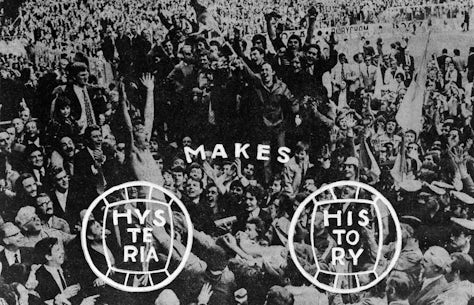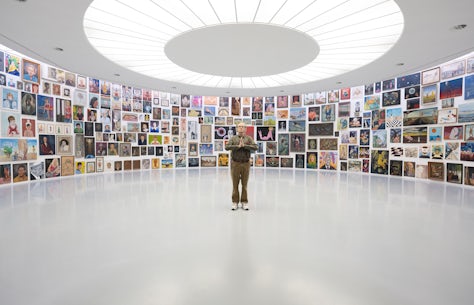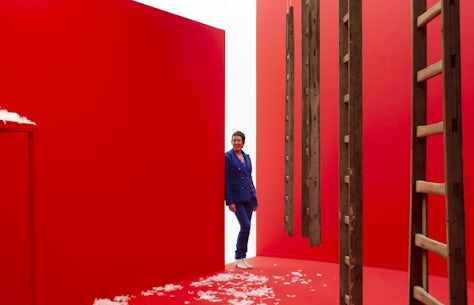
The artist today | Tramaine de Senna
The work of Californian artist Tramaine de Senna is currently on view (were it not for corona perhaps). Those who’ve already visited her explosively titled exhibition MASTERBLASTER might have caught (pun intended) her very contagious spirit, which de Senna cleverly packs in bold coloured, multi-layered exuberance. It’s exactly those layers we’d like to unravel for you in an interview with the ever charming artist herself.

Introduce yourself!
Sure, okay! I’ll try to do it in Nederlands and Engels. Tell me if I sound stupid.
Goeiedag, Ik heet Tramaine de Senna. Ik ben een kunstenaar en ik kom uit Californië. Maar nu heb ik een tentoonstelling hier, in het Museum van Hedendaagse Kunsten.
Hi, my name is Tramaine, I’m an artist from California and now I have an exhibition here at the Museum of Contemporary art in Antwerp.
Your Dutch is outstanding!
Oh thank you, my husband says I sound like a Polish housecleaner.
Your husband is a liar, Ms. de Senna. How long have you lived in this area exactly?
Officially for two years now. Before I spent two years in Ghent and before that two years in The Netherlands. But I always spoke English. I’m only now taking Dutch classes.
Even more impressive.
Thank you! I practiced with ‘bomma’ in Limburg so…that’s always nice.
Time for business, Ms. Let’s start this session with a very general question. What is art to you?
Sure, sure, what is art to me? Art is of course a means of expression. But it can be paradoxical, more than one truth can exist in it. For me, art is something that first does something to my organs inside. Certain sensations occur. I feel it first viscerally and then there’s this thinking process that occurs. I guess art is also a way to redefine or re-examine skill. You know Frank Zappa, the musician? His son, Ahmet Zappa, once said something about “learn and destroy”. It’s basically that for me, coming to terms with certain techniques and skills, but also getting to that point where you can leap over that. The point where you are able to improvise and, again, redefine skill. It comes down to working and creating and doing it over and over again so the art becomes your own. When I’m not making art, I’m always thinking about it. Everything is tied to it.

What really inspires you to create art? Is it nature, or people, arts,…?
How people deal with their humanity, that’s what inspires me. How they overcome obstacles. And the stories that flow from these experiences. For instance, with this work here [talking about the tapestry Chicken Frying, Fire Breathing, Son-of-a-gun]: it’s actually based on the figure of Bobbejaan Schoepen, who has an amusement park in Herentals. I think it’s amazing that he was able to not only be a musician and an entertainer, but also a really good businessman. He was extremely smart in creating a persona. It’s inspiring because it’s such an uplifting story. It was really nice for me to go see his amusement park. It’s his interpretation of the Wild West, or some parts of it. And I am from California, I am from the Wild West. So it’s really cool to see how he used that to create this public persona, as a musician and entertainer. It’s inspiring. He probably had many difficulties in his life too. He was married, he had a family, he ran businesses,…yet he was still able to communicate joy and exuberance. And that’s really uplifting! For me he is a good example of what I like to call “the migration of forms”.



Migration of forms, what’s that now?
Migration of forms can be understood as a form of appropriation, in a way. I’ll give you an example in the context of this exhibition, with Godzilla. Over there on that table, there is a ceramic that I made. It’s a foot, and it’s Godzilla’s foot. When I was eight I was asking about Godzilla to my mom and she was like “Oh yeah, the Japanese made him. He came about after World War II, after the A-Bomb was dropped on Japan”. I was only recently looking into Godzilla again and bumped into someone’s interpretation that Godzilla is a manifestation of the Japanese culture that tried to captivate all the violence that came about. Because his skin resembles the charred skin of bomb victims, covered in keloids and scars. Also, he actually spews radio-active flames. You could say Godzilla is a manifestation of this historic event. Then he entered in the pop-culture realm and now many generations have known of him as such. And this is a migration of form, you know? It starts off with violence and how people try to make sense of it, and then it goes into pop-culture.



When I look at families, you know, there can be drama within them, but why is that? It’s not just because of everyday life. It’s what happened to these people before that shaped them to raise their kids in certain ways. When I see older people on the street, you can kind of tell the generation that came from World War II and those who didn’t, based on how they dress or on how tall they are, because maybe there was famine in their land when they were young. These kind of histories still affect people now, their mind-sets, how they spend their money, how they treat their kids. All these things lead up to how a person sees themselves and how they interact in the world. And these stories are interesting to captivate in new forms and art.
Talking about pop culture. There’s a lot of references to it in your choice of colour, use of textiles and shapes. Please tell us the why and the how.
A lot of these colour patterns, of course, are borrowed. I’ll look at things in pop culture and I’ll study it, like for example certain children’s television shows I grew up with, which happen to have a great understanding of colour. It’s all a surface appearance, things that grab your attention viscerally. To me pop culture is a meeting point for all types of people, the starting point of dialogues and conversations. When I was making this show, I realised there are many ongoing, recurring motifs in the works. For example these hanging fish sculptures I made, to me they resemble a car fender as well. I’ve made works in the past where they refer to automobiles or trains or planes, which were taken from the 1940’s and 1930’s. It was the era of streamline modernism, which I really enjoy because the stripped surfaces create this image of speed. I like this idea of stripping the surface and playing with it. And that all these forms are actually containers of histories, which creates their aesthetic.

How do you put it to practice?
It starts off intuitively, with play. Laying fabrics out and seeing how it works. Through time I recognize an ongoing pattern of interesting faux-fabrics and the different types of specs and patterns that occur. And then it becomes more a thing of practicality. Can I find these materials again? How do I work with these materials? Do I have to add something to them so that they can function? Are these materials only allowed on mushy objects or can I make them hard? So it’s always first intuition which ends up in making pragmatic choices.
What is your favourite working tool?
That’s a good question! I would say a pair of weights. My favourite working tool is a pair of weights for weightlifting, because that, for me, helps me maintain my physical powers. Because now I’m making everything by myself and I need to, kind of, treat myself like an athlete, I guess. To eat right, to sleep correctly, to maintain muscle mass so that I can sew things or make works that are five and a half meters long or sculpt in wax. The body is a tool too and therefore I really need my weights.
When you’re working in your atelier, what is the one thing you can’t do without?
I would say… Can I say two things?
Bring it on!
No, I’ll say one thing. Music. When I’m working in my atelier, the one thing I can’t do without is music, of course. It is the beginning, it’s the soul, in a way, of becoming inspired. And remaining so as well. I was listening quite a bit to James Brown, the godfather of funk, when I was making the magenta chair over here [points to Upholstered Object, No. 2]. I was also listening to The Cramps when I was making this work here [points to the tapestry] and actually I took a lyric from one of their songs, because this work is called Chicken Frying, Fire Breathing, Son-of-a-Gun and that was a really good lyric from one of their songs. I just really loved it. Most musicians are also curious about history and when you read into their lyrics or their stances, it’s really nice to see how they navigate it.


Can you give us an anecdote or a story you will never forget? It can be something completely random or something that might have changed your life in a way? Something extraordinary.
I have all these little stories from being raised by many different aunties who helped take care of me and my sister and all my cousins, which was always nice. I have one auntie, she’s from Hong Kong but she immigrated to the States when she was really young. She would smoke cigarettes, they were called Kool cigarettes? C-o-o-l or K-o-o-l. And when she would drive her van, because she had like five of us kids going to swim practice or karate, she would always stick her left leg up, right against the steering wheel and drive like that and smoke. She introduced me, really, to pop culture. The music. Because she was twenty when she had her first kid, so I was introduced to things in the 80’s that no one else would show me, because she was much younger, you know? She listened to a really cool music station, KMEL, and they would have Janet Jackson and Babyface and all these old school R&B music things. She would perm her hair. To me, she was extremely American and Californian, but also Chinese. And that influenced me. She introduced me to Madonna and all that stuff.


How is life for a Californian girl in Belgium?
I really miss the people in California, I miss the different types of communities and the food. But so far, the worst thing here in Belgium is the weather and that’s it. That’s the worst thing. I can’t complain, it’s pretty great. The Belgian kitchen is very good also (laughs), but the people also. I came from the Netherlands before I came to Belgium. For me it was interesting to see the contrast of two countries that speak the same language but use it differently. I know you hear it all the time. But what I really do like here is that I can ride my bike. And I can get quite a bit done with just my bike.
True. Do you consider yourself a patriot?
I guess so… I mean… Yeah I am. I do consider myself a patriot at times, only because I’ve had the privilege to leave my country and view it from afar. And then I can recognise even more the faults and the good things. It makes me more aware of myself and how things come to be. Cellist Yo-Yo Ma said something like “It takes three generations to make an artist, if you’re an immigrant”. The first generation has to climb out of poverty, the second generation has to get an education and this third generation can pursue art. And I think John Adams, an old American politician, once said something similar when he was writing to his wife Abigail and he said something like: “We must study architectural engineering and war and history so that our sons and daughters can go on and study music and art and sculpture.”
And do you feel like you can relate it to your own family history?
Yeah I can, and it’s interesting. My mom’s side, they are a little bit of immigrants, but they’ve always been in the United States, they’re native Americans and descendants of slaves as well. My dad’s side immigrated from China to California, but they were also mixed. They were part Dutch and Portuguese from the trade in the 1500’s. It’s funny because I kind of view them as “in-between”, but everyone is in a way. You are very much your country and you’re also something within your family or your community as well.

When did you first know that you wanted to be an artist or a maker or creator?
I always wanted to make art, but I think children always start that way. The thing that was difficult for me was that I didn’t think, in this lifetime, I could be an artist. I thought I would have to die and come back and remember it, because I couldn’t see a way out of the United States and paying for art school. But I always wanted to do it, I just didn’t always know how to do it. It took time, a lot of work, going to school and earning money to realise “Okay, these are my plans. I have a limited amount of time in my lifetime, I have to do this.”.
What would your advice be to eighteen year old Tramaine?
Don’t stress out, just keep working, make connections and maintain those connections. When I went to my university I didn’t realise the difference of people who were going there. You have the children of very wealthy people and you have the immigrants coming in, working super hard. I didn’t realise that that was the place to make connections. I was just focused on getting good grades and everything remained abstract. And this one goes out to all the artists: just keep working. Just keep working, that’s how it comes. You make your own. You make your own style, you redefine your own style. You find your own skill that way, just by working.
Are there any specific artists or works that have always been an inspiration to you?
The first that comes to mind is the Isenheim Altarpiece by Matthias Grünewald. It’s this image of Christ, he’s being crucified, but he’s extremely green and grey and his hair is kind of reddish. His skin is totally defiled, rotting and bleeding. I really like that because it was painted on a wooden panel with oils, I think. I’ve never seen it in person, I’ve only seen copies, but it’s just a really visceral embodiment of suffering, free from any religious connotation. I also loved Francis Bacon when I was in art school. Other things that inspire me is just material culture, everywhere. At the drug store, at the supermarket, at the plastic euro store. All those things are great!

Thinking of Francis Bacon and the altarpiece you described, would you say emotion is important to you?
Emotion is important, however I have to keep it in check, make sure to observe myself at a distance so that it doesn’t overrule.
If you weren’t an artist, what would you choose to be instead?
If I was not an artist, I would probably have pursued architecture. I was in it for about three years, but I wanted to pursue art. I would just go back into architecture. Because it’s also a mixture of something creative. However, there’s quite a bit of pragmatic things and it’s a lot fun to build tiny models. But then how do you bring that into existence? And you’re dealing with all these great new technologies and people and what the clients want, but also history. That’s just a nice set of constraints.
Apart from art and making art, what else keeps you busy?
In a very practical sense, just cleaning. Lots of cleaning (laughs). Because a large majority of art is cleaning up or setting up. Or finding safety equipment. And then back to life at home, making sure to keep the place clean, cooking, all that stuff. Visiting parents, cooking for them. Visiting relatives, cooking for them.
Thank you, Tramaine. We’ll leave you to that then.



